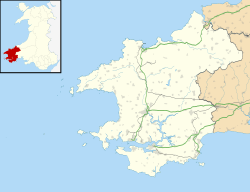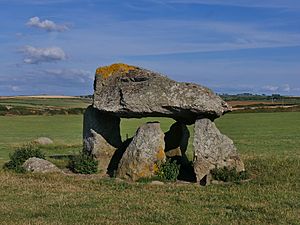Carreg Samson facts for kids
 |
|
| Location | Pembrokeshire |
|---|---|
| Coordinates | 51°57′30″N 5°07′58″W / 51.958386°N 5.132704°W |
| Type | Dolmen |
| History | |
| Periods | Neolithic |
Carreg Samson is an amazing ancient stone structure in Wales. It's also called Samson's Stone or the Longhouse. This special place is about 5,000 years old! It's a type of ancient tomb called a dolmen, built by people in the Neolithic period. You can find it near Abercastle, close to the beautiful Pembrokeshire Coast Path.
Contents
Why is it Called Carreg Samson?
The name "Samson" comes from a cool local story. Legend says that a saint named Saint Samson of Dol was so strong, he could lift the huge top stone (called a capstone) and put it in place using just his little finger! That's why it's known as Samson's Stone.
What Does Carreg Samson Look Like?
Carreg Samson is made up of several very large stones. The biggest one is the "capstone," which sits on top. This capstone is huge, measuring about 4.7 meters long, 2.7 meters wide, and 1 meter thick.
The Supporting Stones
The giant capstone rests on three of six standing stones. These supporting stones are quite tall, ranging from 1.1 to 2.2 meters high. Imagine how strong the ancient builders must have been to move these!
How it Was Used Long Ago
Originally, this stone structure was part of a burial chamber. It was completely covered by a big mound of earth or smaller stones. Over time, this mound disappeared. People later used the exposed stone structure as a shelter for sheep by blocking the gaps between the stones.
Discoveries from Excavations
Archaeologists explored Carreg Samson in 1968. They found four more spots where stones once stood. One of these spots likely held another chamber stone. The others might have been part of a passage leading out to the northwest.
They also found small traces of the original stone mound to the south. It was discovered that the monument was built over a pit about 0.8 meters deep, filled with clay and stones. Inside, they found small pieces of burnt bone, pottery, and flint tools. These finds help us learn about the people who built and used Carreg Samson thousands of years ago.
Images for kids





